|
Conclusion
The foregoing survey may convince an impartial student of history
that the ancient Hindus had evolved precepts on fair fighting which
formed a chivalrous code of military honor.
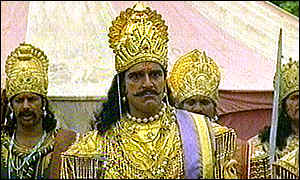
On the whole, however, it would seem that wars in ancient India were
characterized by less violence and savagery than wars elsewhere.
There is no recorded instance of such wanton and cold-blooded
atrocity as Athens perpetrated against Melos, Corcyra and Mytilene,
or the wearers of the Cross against the defenders of the Crescent in
1099 A.D. Such incidents of war as the indiscriminate slaughter of
all men of military age or the enslavement of women and children of
the conquered state were hardly known. On the whole, the chiefs were
considerate of each other's rights.
This was also the Kautilyan ideal of dharmavijayan, and the typical
Hindu method of creating unity out of diversity in the political
sphere. It was a well-established maxim of statecraft that a victor
should acquiesce in the continuance of the laws, beliefs and customs
of the vanquished peoples, and that instead of seeking to
extermination of the defeated dynasties, he should be content with
submission and tribute. It is also the reason why some of the
princely families in India can boast of an ancestry unequalled by
any royal house in Europe.
It is of paramount importance to remember that in India the social,
economic and religious life of the people pursued their course
irrespective of the activities of the state. As early as as the 4th
century B.C. Megasthenes noticed a peculiar trait of Indian warfare.
"Whereas among other nations it is usual in the contests of war to
ravage the soil, and thus to reduce it to an uncultivated waste,
among the Indians, on the contrary, by whom husbandmen, the tillers
of the soil, even if battle is raging in the neighborhood, are
undisturbed by any sense of danger, for the combatants on either
side, in waging the conflict, make carnage of each other but allow
those engaged in husbandry to remain quite unmolested. Besides they
never ravage an enemy's land with fire nor cut down its trees."
The
modern "scorched earth" policy was then unknown.
Professor H. H. Wilson says:
"The Hindu laws of war are very
chivalrous and humane, and prohibit the slaying of the unarmed, of
women, of the old, and of the conquered."
At the very time when a battle was going on, be says, the
neighboring cultivators might be seen quietly pursuing their work, -
" perhaps ploughing, gathering for crops, pruning the trees, or
reaping the harvest." Chinese pilgrim to Nalanda University, Hiuen
Tsiang affirms that although there were enough of rivalries and wars
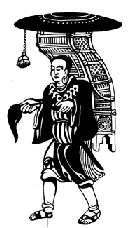 in the 7th century A.D. the country at large was little injured by
them. in the 7th century A.D. the country at large was little injured by
them.
Colonel James Tod, author of
Annals and Antiquities of Rajasthan: or
the Central and Western Rajput States of India (April 1998) wrote:
"To spare a prostrate
foe is the creed of the Hindu cavalier, and he carried all such
maxims to excess."
What were the causes which led to the downfall of the Hindus? Why
did the Indian states fall prey to the Muhammadan Turks in the 11th
and 12th century?
King Asoka wanted to convert his empire into an open-air Buddhist
monastery, at the expense of Hindu taxpayers whose interests in turn
were marginalized. Buddhist principles derided martial prowess and
criminally neglected the intrepidity and valor which fought for
national independence. The excessive propaganda for unrestricted
ahimsa which King Asoka carried on by his use of political authority
throughout his empire, cut at the very root of the Indian empire.
For a few generations following Ashoka's demise, 'non-violent'
Buddhists ate into the vitals of India's external defense, leaving
the country vulnerable to a second wave of Greek attacks.
According to Priyadarshi Dutta:
"The Greeks, who had concluded a treaty with Chandra-gupta Maurya,
moved in to Ayodha before the Kalinga King Kharvela repulsed them.
Later Pushyamita Sunga assassinated the last Maurya King and
salvaged India. Buddhism vanished from India as a result of Muslim
onslaught because none of them had the liver of the likes of say,
Guru Govind Singh. While Hindus and Sikhs resisted Muslim onslaught,
Buddhist submitted en mass to Islam."
The Hindu defenders of the country although fully equal to their
assailants in courage and contempt of death were nevertheless,
divided among themselves. This division and disunion also enabled
the crafty Turk invaders from the north to exploit the differences
within the country. Hindus were more civilized and prosperous than
the Turks. Moreover, the Turks had rude rigor of a semi-civilized
barbarians who combined the fierce religious zeal of neo-converts.
To spread their faith by conquest doubled their natural zest for
battle and endowed them with the devoted valor of martyrs. In
addition, the concept of ahimsa tended to create in certain sections
of Hindus a deep abhorrence to all forms of violence.
The Bhagavad Gita's great message: that violence is sometimes
necessary, if it flows from Dharma.
Non-violence in thought, word and deed is the ideal of the yogi, as
the Gita points out. Violence is never an ideal in a civilized
society, but it cannot be avoided. Rulers of society have to employ
it for their preservation. Even this terrible action can be
performed as selfless service when lawless societies (eg. Muhammadan
Turks or Europeans who came to India as invaders) prey upon others
out of greed.
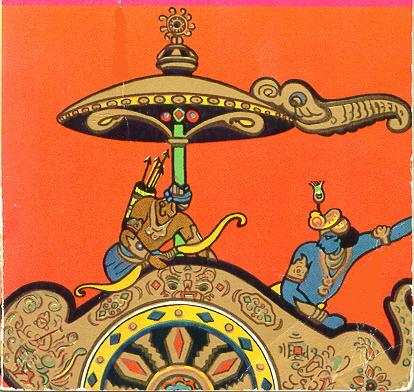
The Bhagavad Gita's great message: that violence is sometimes
necessary, if it flows from Dharma
For a warrior, nothing is higher than a war
against evil.
The warrior confronted with such a war should be pleased, Arjuna,
for it comes as an open gate to heaven.
But if you do not participate in this battle against evil, you will
incur sin, violating your dharma and your honor....
- Bhagavad Gita 2.31-33
Books used for this chapter
Back to Contents
Articles
Sailors of Sixty Centuries
Yukikalpataru, a Sanskrit manuscript compilation by Bhoja Narapati,
which manuscript is now in the Calcutta Sanskrit College Library, is
something like a treatise, on the art of shipbuilding in Ancient
India.
It gives, according to Vriksha-Ayurveda (“Botany”), an account of
four different kinds of wood. The first class comprises wood, that
is light and soft, and can be joined to any other wood. The second
class is light and hard, but cannot be joined to any other class of
wood. The third class of wood is soft and heavy. Lastly the fourth
kind is hard and heavy. According to Bhoja, a ship made out of the
second class of wood, brings wealth and happiness. Ships of this
type can be safely used for crossing the oceans. Ships made out of
timbers containing different properties are not good, as they rot in
water, and split and sink at the slightest shock.
Bhoja says that care should be taken that no iron be used, in
joining planks, but they be subjected to the influence of magnetism,
but they are to be fitted together with substances other than iron.
Bhoja also gives names of the different classes of ships:
The measurements in cubits of the “Ordinary class” of ships are the
following:
|
|
|
Length |
Breadth |
Height |
|
1. |
Kshudra |
16 |
4 |
4 |
|
2 |
Madhyama |
24 |
12 |
8 |
|
3 |
Bhima |
40 |
20 |
20 |
|
4 |
Chapala |
48 |
24 |
24 |
|
5 |
Patala |
64 |
32 |
32 |
|
6 |
Bhaya |
72 |
36 |
36 |
|
7 |
Dirgha |
88 |
44 |
44 |
|
8 |
Patraputa |
96 |
48 |
48 |
|
9 |
Garbhara |
112 |
56 |
56 |
|
10 |
Manthra |
120 |
60 |
60 |
Bhima, Bhaya, Garbhara are liable to bring ill-luck because their
dimensions are such as not to balance themselves in water.
Among the “Special” are two classes.
|
1. Dirgha
|
|
|
Length |
Breadth |
Height |
|
1. |
Dirghika |
32 |
4 |
31/5 |
|
2 |
Tarani |
48 |
6 |
44/5 |
|
3 |
Lota |
64 |
8 |
62/5 |
|
4 |
Gatvara |
80 |
10 |
8 |
|
5 |
Gamini |
96 |
12 |
92/5 |
|
6 |
Tari |
112 |
14 |
111/5 |
|
7 |
Jangala |
128 |
16 |
124/5 |
|
8 |
Plavini |
144 |
18 |
142/5 |
|
9 |
Dharnini |
160 |
20 |
16 |
|
10 |
Begini |
176 |
22 |
173/5 |
2. Unnanta
|
a |
Urddhva |
22 |
16 |
16 |
|
b |
Anurddva |
48 |
24 |
24 |
|
c |
Svanamukhi |
64 |
32 |
32 |
|
d |
Gharbhini |
80 |
40 |
40 |
|
e |
Manthara |
96 |
48 |
48 |
|
|
Lota, Gamini, Plavini, Anurddhava, Gharbhini, Manthara bring
misfortune, because of their dimensions, and Urddhva much gain.
The “Yaktikalpataru” also suggests the metals to be used in
decorations, eg. Gold, silver, copper, and compounds of all three as
well as the colors. A vessel with four masts is to be painted white,
the one with three masts is to be given a red paint, a two masted
vessel is to be colored yellow, and a one masted vessel is to have a
blue color. The prows are to be shaped into the form of heads of
lions, buffalos, serpents, elephants, tigers, ducks, pea-hens,
parrots and human beings, thus arguing an advanced progress in
carpentry. Pearl and gold garlands are to decorate the prows.
Three classes of Ships
According to cabins, ships are to be grouped into three classes:
Sarvamandira ships, having the largest cabin, from one end of the
ship to the other. These are to be used for the transportation of
the royal treasury, of women and horses. Madhyamandira ships, with
cabins in the rainy season. Ships with cabins near the prows, are
called Agramandira, and are for sailings in the dry seasons as well
as for long voyages, and naval warfare.
It was in these ships, that
the first naval battle recorded in Indian literature, was fought,
when Tugra, the Rishi King, sent his son Bhujyu against his enemies
inhabiting some Island, and Bhujya on being wrecked, was rescued by
two Asvins, in their hundred oared gallery. Of the same description
are the five hundred vessels, mentioned in the Ramayana.
Carried 1000 Passengers
In Rajavalliya, the ship in which Prince
Vijaya and his followers were sent away by King Sinhala of Bengal,
was large enough to accommodate seven hundred passengers. The ship
in which Prince Vijaya’s bride was conveyed to Sri Lanka, was big
enough to accommodate eight hundred people of the bride’s party. The
ship which took Prince Sinhala to Sri Lanka contained five hundred
merchants besides the Prince himself.
The Janaka Jataka mentions a
ship-wreck of seven hundred passengers. The ship by which was
effected the rescue of the Brahmin mentioned in Sankha Jataka was
800 cubits in length, 600 cubits in width, 20 fathoms deep, and had
three masts. The ship mentioned in the Samuddha Vanija Jataka was
big enough to transport a village full of absconding carpenters,
numbering a thousand, who had failed to deliver goods paid for in
advance.
Early History
An ancient couplet betrays the spirit with which the
Indians were imbued and which accounts for their wonderful
achievements on land, beyond seas and across mountain barriers.
There is indeed evidence to show that the sons of the soil were
adept at navigation both riverine and oceanic. Right from the dawn
of history, therefore, Indians have been engaged in plying boats and
ships, carrying cargoes and passengers, manufacturing vessels of all
types and dimensions, studying the stars and winds, erecting
light-houses and building ports, wharfs, dockyards and warehouses.
From rustic beginnings they developed a precise science of
navigation and composed regular manuals as well as elaborate
treatises on the subject, some of which survive to this day. It is
noteworthy that the very term navigation is derived from nau, which
in Sanskrit word for ‘ship’ or ‘boat’. Thus navi gatih ‘going in a
boat’ amounts to ‘navigation’.
Literary Evidence
Sanskrit literature is full of references to
river transport and sea voyages. Sometimes we have graphic
descriptions of fleets, even of ship-wrecks. The Rig-Veda is taken
as the earliest extant work of the Aryans, though there is no
general agreement as to its exact age. At one place, Rishi Kutsa
Angirasa prays to Agni:
“Remove our foes as if by ship to the yonder
shore. Carry us as if in a ship across the sea for our welfare.”
In Ramayana: In Valmiki’s Ramayana, we come across beautiful
descriptions of large boats plying on the Ganga near Sringiberapura.
King Guha of that place arranges a magnificent boat for Rama
accompanied by Lakshman and Sita, in exile, to enable the party to
cross the river.When Bharat comes later to the same place, with the
whole royal household, citizens of Ayodhya and a large army, with
the intention of bringing Rama back to Ayodhya from exile, the same
King Guha, suspecting Bharata’s intentions, take precautionary
measures by ordering five hundred ships, each manned by one hundred
youthful mariners to keep in readiness, should resistance be
necessary.
The descriptions of the ships is noteworthy:
“Some (of the ships)
reared aloft the swastika sign, had tremendous gongs hung, flew gay
flags, displayed full sails and were exceedingly well built”
The
ships chosen for Bharata and the royal ladies of the royal household
had special fittings and furniture as well as yellow rugs.
In Mahabharata
In the Mahabharata too there are many references.
The ship contrived by Vidura for the escape of Pandavas had some
kind of mechanism fitted in it: “the ship strong enough to withstand
hurricanes, fitted with machinery and displaying flags.” Panini, who
lived about the 7th century B.C. in his Ashtadhyayi, the most
commented upon work on Sanskrit grammar, has incidentally recorded
certain usages which reflect in a way the maritime activity before
and during his days in India.
According to one sutra various types
of small river craft were in use, and their names were utsagna,
udupa, udyata, utputa, pitaka etc. A large boat was called Udavahana
or udakavahana. Of special interest is the distinction made between
the cargoes coming from an island near the coast and those coming
from mid-ocean islands: the former were called dvaipya, and the
latter dvaipa or dvaipaka. Certain other sutras speak of ferry
chages, cargoes, marine trade and the like of those days.

Chandragupta Maurya’s minister, Vishnugupta Chanakya alias Kautilya,
the celebrated author of the treatise on statecraft, Kautilya
Arthasastra, of about 320 B.C. devotes a full chapter to waterways
under a Navadhyaksha ‘Superintendent of ships’. His duties included
the examination of accounts relating to navigation, not only on
oceans and mouths of rivers, but also on lakes, natural or
artificial, and rivers.
Fisheries, pearl fisheries, customs on
ports, passengers and mercantile shipping, control and safety of
ships and similar other affairs all came under his charge. Jaina
scriptures, Buddhist Jatakas and Avadanas, as well as classical
Sanskrit literature, abound in references to sea-voyages. They
acquaint us with many interesting details as to the sizes and shapes
of ships, their furniture, and decorations, articles of import and
export, names of seaports and islands, in short, everything
connected with navigation.
Temples Give Proof
In the temple of Jagannath at Puri, a stately
barge is sculptured in relief. The oarsmen paddle with all their
strength, the water is thrown into waves, and the whole scene is one
of desperate hurry. The boat is of the Madhyamandira type, as
defined by Bhoja in the “Yuktikalpataru”. The Ajanta paintings are
rightly interpreted by Griffiths as a "vivid testimony to the
ancient foreign trade of India." Of the many paintings one is of “a
sea-going vessel with high stem and stern with three oblong sails
attached to as many upright masts.
Each masts is surrounded by a
truck and there is carried a big sail. The jib is well filled with
wind. A sort of bowspirit, projecting from a kind of gallows on deck
is indicated with the outflying jib, square in form,” like that of
Columbus ships. The ship is of the Agramandira type, as described in
the “Yuktikalpataru”. Another painting is of a royal pleasure boat
which is,
“like the heraldic lymphad, with painted eyes at stem and
stern, a pillard canopy amid ships, and an umbrella forward the
steersman being accommodated on a sort of ladder, which remotely
suggest the steerman’s chair, in the modern Burmese row boats, while
a rower is in the bows.”
The barge is of the Madhyamandira type.
Sculpture at Borobudur
The temple of Borobudur in Java contains
sculptures recalling the colonization of Java by Indians. One of the
ships “tells more plainly than words, the perils, which the Prince
of Gujarat and his companions encountered on the long and difficult
voyages from the west coast of India.” There are other ships
tempest-tossed on the Ocean, fully trying to pluck and dexterity of
the oarsmen, sailors, and pilots, who, however, in their movements
and looks impress one with the idea, that they were quite equal to
the occasion.
What Historian say: Nicolo Conti says:
"The natives of India build some ships larger than ours, capable of
containing 2,000 butts, and with five sails and as many masts. The
lower part is constructed with triple planks, in order to withstand
the force of the tempests, to which they are much exposed. But some
ships are so built in compartments, that should one part be
shattered, the other portion remaining whole may accomplish the
journey."
Mr. J. L. Reid, member of the Institute of Naval Architects and
Shipbuilders, England and the Superintendent of the Hongli Docks,
has stated:
“The early Hindu astrologers are said to have used the magnet as
they still use the modern compass, in fixing the north and east, in
laying foundations, and other religious ceremonies. The Hindu
compass was an iron fish, that floated in a vessel of oil, and
pointed, to the north. Fact of this older Hindu compass seems placed
beyond doubt by the Sanskrit word “maccha-yantra.”
India’s extensive Sea-borne Trade: The historian Strabo says that in
the time of Alexander, the River Oxus was so easily navigable that
Indian wares were conducted down it, to the Caspian and the Euxine
sea, hence to the Mediteranean Sea, and finally to Rome. Greeks and
Indians began to meet at the newly established sea ports, and
finally all these activities culminated in Indian embassies, being
sent to Rome, from several Indian States, for Augustus himself says
that Indian embassies came “frequently.” Abundant Roman coins from
Augustus right down to Nero, have been found in India.
Archaeologist’s Testimony
Archaeology amply supports literary
record. Excavations at Mohenjodaro on the Indus have yielded, among
other things, a potsherd and couple of steatite, seals each bearing
a representation of a boat or a ship incised on it. By far the most
substantial proof is afforded by the discovery of a dockyard at
Lothal in Gujarat.
The eminent Indian archaeologist Dr. Bahadur Chand Chhabra
concludes:
“It may be a surprise even to an Indian today to be told that in the
ancient world India was in the forefront in the field of shipping
and ship-building. Her ships, flying Indian flags, sailed up and
down the Arabian Sea, the Indian Ocean and far beyond to Southeast
Asia. Her master-mariners led the way in navigation. Riverine
traffic within the country, shipping along the entire length of
India’s coastline, and on high seas were brisk until as recently as
the days of the East India Company.
Owing however, to historical
competition by the British, ancient Indian shipping was wiped out
without a trace. No wonder then the common man in India today
readily believes that Indians are not only now learning the ABC of
navigation. It would have been odd indeed if, bounded on three sides
by great oceans, and gifted with a remarkable spirit of enterprise
and invention, India had registered no advancement in the sphere of
navigation while she had gone far in other arts and sciences.
(source:
Hindu America: revealing the story of the romance of the Surya Vanshi Hindus and depicting the imprints of Hindu culture on
the two Americas - By Chaman Lal with foreword by Dr. S.
Radhakrishnan. 3d ed. (LC History-America-E) 1966).
U.S. adopts
catamaran technology
Washington May 28.
The United States adopted ancient Indian
catamaran-making technology to construct fast ships which were used
with dramatic effect in the Iraq war, says a media report.
Among the equipment the Americans used to win the Iraq war were
100-feet catamaran ships to ferry tanks and ammunition from Qatar to
Kuwait.
The ships, built with technology adapted from ancient Tamil methods
to make catamarans, can travel over 2,500 kms in less than 48 hours,
twice the speed of the regular cargo ships, and carry enough
equipment to support about 5,000 soldiers, the Wall Street Journal
reported yesterday.
Having a shallow draft, the boats can unload in rudimentary ports,
allowing troops to land closer to the fight. — PTI
(source:
U.S. adopts Indian Catamaran technology - hindu.com and
tribune.com).
Sailing down
the seas of history
Charting the coastline from Mumbai to the very end of Gujarat, where
India ends and Pakistan begins, the 1,000 nautical mile voyage that
will end on February 11 is in preparation for another, more
ambitious voyage. The sailors, calling themselves the Maritime
Exploration and Research Group, is getting ready to follow the path
of ancient Indian mariners from south India all the way to
Indonesia.
Inspired by the Chola kings of the 11th century, who discovered the
present-day Indonesian islands of Sumatra and Bali, the group is
preparing to replicate the feat using traditional instruments and a
boat resembling the vessels of yore.
Called the Simulation of Chola Navigation Techniques, the
forthcoming expedition will attempt to cover the distance between
Nagapatnam in southern India and the Indonesian islands. "The
expedition will aim to show that our ancient seafarers were in no
way inferior to their Western counterparts," said B. Arunachalam, a
researcher who is the moving spirit behind the expedition. The
expedition has cost the team members nearly Rs.100,000 but they have
received substantial assistance from the Indian Navy.
(source:
Sailing down the seas of history - newindpress.com)
India defense
looks to ancient text
Indian scientists are turning to an ancient Hindu text in their
search for the secrets of effective stealth warfare.
They believe the book, the Arthashastra, written more than 2,300
years ago, will give Indian troops the edge on their enemies.
India's Defence Minister George Fernandes has approved funding for
the project, and told parliament recently that experiments had
begun. The research is being carried out by experts from the Defence
Research and Development Organisation and scientists from the
University of Pune and National Institute of Virology in western
India. The book includes the recipe for a single meal that will keep
a soldier fighting for a month, methods of inducing madness in the
enemy as well as advice on chemical and biological warfare.
Powders and remedies
The book was written by military strategist Kautilya, also known as
Chanakya and Vishnugupta, a prime minister in the court of India's
first emperor Chandragupta Maurya, in the fourth century BC.
"All of us are excited about the possibilities and do not for a
moment think that the idea is crazy," said Professor SV Bhavasar, a
space scientist who has spent many years researching the
Arthashastra.
"Decoding ancient texts is not an easy task but we are very hopeful
of success," he added. According to a Pune University report, the
book says that soldiers fed with a single meal of special herbs,
milk and clarified butter can stay without food for an entire month.
Shoes made of camel skin smeared with a serum made from the flesh of
owls and vultures can help soldiers walk hundreds of miles during a
war without feeling tired. A powder made from fireflies and the eyes
of wild boar can endow soldiers with night vision.
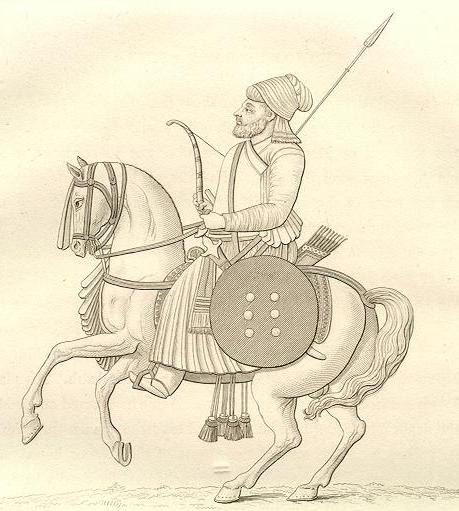
(source: Annals and Antiquities of Rajasthan: or the Central and
Western Rajput States of India - By Colonel James Tod).
Chemical
warfare
Kautilya wrote in the Arthashastra that a ruler could use any means
to attain his goal, and Book XIV touches on aspects of chemical and
biological warfare.
The book says that smoke from burning a powder made from the skin
and excreta of certain reptiles, animals and birds can cause madness
and blindness in the enemy. The book also provides the formula to
create a lethal smoke by burning certain species of snakes, insects
and plant seeds in makeshift laboratories.
"Our focus at present is on how humans can control hunger for longer
durations and walk for longer period without experiencing fatigue,
Project leader Dr V S Ghole, head of the environmental engineering
department of Pune university, said the team was now focusing on the
methods of controlling hunger and increasing stamina.
"Once we have made some headway we will go into researching
Kautilya's notes on night vision and other fields," he said.
Professor S V Bhavasar said the team also had plans to research
other ancient Hindu texts. These include manuscripts which "claim to
provide secrets of manufacturing planes which can not be destroyed
by any external force, could be motionless in the sky and even
invisible to enemy planes."
(source:
http://news.bbc.co.uk/hi/english/world/south_asia/newsid_1986000/1986595.stm).
Did You Know?
Gun powder (Agnicurna) and Ancient Hindus
-
Sir A. M. Eliot tells us that the Arabs learnt the manufacture of
gunpowder from India, and that before their Indian connection they
had used arrows of naptha. It is also argued that though Persia
possessed saltpetre in abundance, the original home of gunpowder was
India. It is said that the Turkish word top and the Persian tupang
or tufang are derived from the Sanskrit word dhupa. The dhupa of the
Agni Purana means a rocket, perhaps a corruption of the Kautaliyan
term natadipika.
(source: Fire-Arms in Ancient India - By Jogesh Chandra Ray I.H.Q.
viii. p. 586-88).
-
Heinrich Brunnhofer (1841-1917) German Indologist, also believed
that the ancient Aryans of India knew about gunpowder.
(source: German Indologists: Biographies of Scholars in Indian
Studies writing in German - By Valentine Stache-Rosen. p.92).
-
Gustav Oppert (1836-1908) in his work, Political Maxims of the
Ancient Hindus, says, that ancient India was the original home of
gunpowder and fire-arms.
It is probable that the word Sataghni referred to in the Sundara
Kanda of the Ramayana refers to cannon.
(source: Hindu Culture and The Modern Age - By Dewan Bahadur K.S.
Ramaswami Shastri - Annamalai University 1956 p. 127).
-
Professor Horace Hayman Wilson says:
“Amongst ordinary weapons one
is named vajra, the thunderbolt, and the specification seems to
denote the employment of some explosive projectile, which could not
have been in use except by the agency of something like gunpowder in
its properties.”
"The Hindus, as we find from their medical writings, were perfectly
well acquainted with the constituents of gun-powder - sulphur,
charcoal, saltpetre - had them all at hand in great abundance. It is
very unlikely that they should not have discovered their
inflammability, either singly or in combination. To this inference a
priori may be added that draws from positive proofs, that the use of
fire as weapon of combat was a familiar idea, as it is constantly
described in the heroic poems."
(source: Essays and lectures on the religions of the Hindus - H H
Wilson vol. II p. 302)
It is very unlikely that they should not have discovered their
inflammability, either singly or in combination. To this inference a
priori may be added that drawn from positive proof, that the use of
fire as a weapon of combat was a familiar idea, as it is constantly
described in the heroic poems.”
The testimony of ancient Greek writers, who, being themselves
ignorant of fire-arms used by Indians, give peculiar descriptions of
the mode of Hindu warfare is significant.
“Themistius mentions the
Brahmin fighting at a distance with lightning and thunder.”
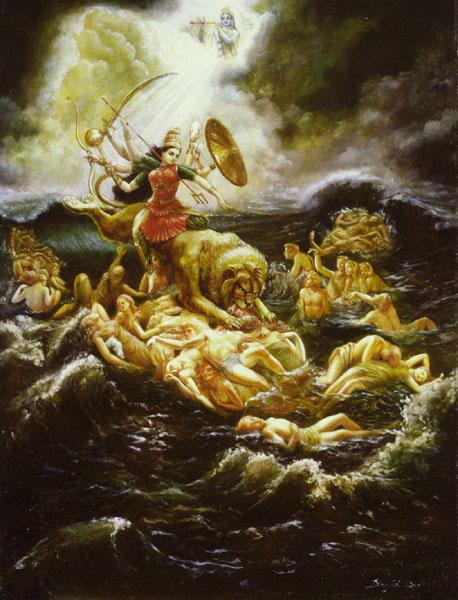
Goddess Kali at war
Alexander, in a letter to Aristotle, mentions,
“the terrific flashes
of flame which he beheld showered on his army in India.”
(See
Dante’s Inferno, XIV, 31-7).
Speaking of the Hindus who opposed Alexander, Lord
Elphinstone says:
“Their arms, with the exception of fire-arms, were the same as at
present.”
(source: History of India - by Mountstuart Elphinstone p. 241).
Philostratus thus speaks of Alexander’s invasion of the Punjab:
“Had
Alexander passed the Hyphasis he never could have made himself the
master of the fortified habitations of these sages. Should an enemy
make war upon the, they drive him of by means of tempests and
thunders as if sent down from Heaven. The Egyptian Hercules and
Bacchus made a joint attack on them, and by means of various
military engines attempted to take the place. The sages remained
unconcerned spectators until the assault was made, when it was
repulsed by fiery whirlwinds and thunders which, being hurled from
above, dealt destruction on the invaders.”
(source: Philostrati Vit: Apollo, Lib II. C. 35).
Commenting on the stratagem adopted by King Hal in the battle
against the king of Kashmir, in making a clay elephant which
exploded, H M. Elliot says:
“Here we have not only the simple act of
explosion but something very much like a fuse to enable the
explosion to occur at a particular period.”
(source: The History of India, as told by its own Historians - By H.
M Elliot volume I. p. 365).
Though the Hindu masterpieces on the science of war are all but
lost, yet there is sufficient material available in the great epics
and the Puranas to prove that fire-arms were not only known and used
on all occasions by the Hindus, but that this branch of their armory
had received extraordinary development. In medieval India, of
course, guns and cannons were commonly used. In the 12th century we
find pieces of ordnance being taken to battle fields in the armies
of Prithviraj.
In the 25th stanza of Pritviraja Rasa it is said that,
“The calivers and cannons made a loud report when they were fired
off, and the noise which issued from the ball was heard at a
distance of ten cos. An Indian historian, Raj Kundan Lall, who lived
in the court of the King of Oudh, says that there was a big gun
named lichhma in the possession of His Majesty the King (of Oudh)
which had been originally in the artillery of Maharaja of Ajmer. The
author speaks of a regular science of war, of the postal department,
and of public roads. “Maffei says that the Indians far excelled the
Portuguese in their skill in the use of fire-arms.”
Another author quoted by Peter Von Bohlen (1796-1840) German
Indologist, speaks of a certain Indian king being in the habit of
placing several pieces of brass ordnance in front of his army.
“Faria-e-Souza speaks of a Guzerat vessel in A.D. 1500 firing
several guns at the Portuguese, and of the Indians at Calicut using
fire vessels in 1502, and of the Zamorin’s fleet carrying in the
next year 380 guns.”
(source: Hindu Superiority - By Har Bilas Sarda p. 355-360).
In the light of the above remarks we can trace the evolution of
fire-arms in the ancient India. There is evidence to show that agni
(fire) was praised for vanquishing an enemy. The Arthava Veda shows
the employment of fire-arms with lead shots. The Aitareya Brahmana
describes an arrow with fire at its tip. In the Mahabharata and
Ramayana, the employment of agnyastras is frequently mentioned, and
this deserves careful examination in the light of other important
terms like ayah, kanapa and tula-guda.
The agnicurna or gunpowder was composed of 4 to 6 parts of saltpetre,
one part of sulphur, and one part of charcoal of arka, sruhi and
other trees burnt in a pit and reduced to powder. Here is certain
evidence of the ancient rockets giving place to actual guns in
warfare. From the description of the composition of gunpowder, the
composition of the Sukraniti can be dated at the pre-Gupta age.
(source: War in Ancient India - By V. R. Ramachandra Dikshitar 1944.
p. 103 -105).
Medhatithi remarks thus,
"while fighting his enemies in battle, he
shall not strike with concealed weapons nor with arrows that are
poisoned or barbed on with flaming shafts."
Sukraniti while referring to fire-arms, (agneyastras) says that
before any war, the duty of the minister of war is to check up the
total stock of gunpowder in the arsenal. Small guns is referred as
tupak by Canda Baradayi. The installation of
yantras (engines of
war) inside the walls of the forts referred to by Manasollasa and
the reference of Sataghni (killer of hundreds of men) pressed into
service for the protection of the forts by Samaranganasutradhara
clearly reveals the frequent use of fire arms in the battle-field.
(source: India Through The Ages: History, Art Culture and Religion -
By G. Kuppuram p. 512-513).
The use of gunpowder, first invented and used in India as an
explosive mixture of saltpetre, sulfur and charcoal to power guns,
cannons and artillery.source: How to Read the Timeline Hinduism Today).
H.H. Eliot, Foreign Secretary to the Government of India (1845),
after discussing the question of the use of fire-arms in ancient
India, says:
"On the whole, then, we may conclude that fire-arms of
some kind was used in early stages of Indian history, that the
missiles were explosives....that projectiles were used which were
made to adhere to gates and buildings, and machines setting fire to
them from a considerable distance; that it is probable that saltpetre, the principal ingredient of gunpowder, and the cause of
its detonation, entered into the composition, because the earth of
Gangetic India is richly impregnated with it in a natural state of
preparation, and it may be extracted from it by lixiviation and
crystallization without the aid of fire; and that sulphur may have
been mixed with it, as it is abundant in the north-west of India."
(source: Historians of M India - Bibliographical Index. Vol. I p.
373).
Horace Hayman Wilson wrote:
"Rockets appear to be of Indian
invention, and had long been used in native armies when Europeans
came first in contact with them." "It is strange that they (rockets)
should now be regarded in Europe as the most recent invention of
artillery."
(source: Annals and Antiquities of Rajasthan: or the Central and
Western Rajput States of India - By James Tod South Asia Books; ; 2
edition (April 1998) ISBN 8120803809 Vol. II p. 220 and (source:
Historians of M India - Bibliographical Index. Vol. I p. 373 and
357).
Back to Contents
Images of Some
Weapons
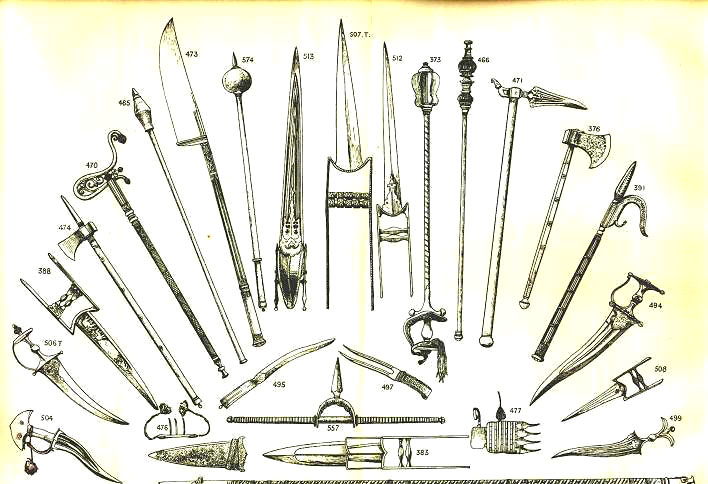
Maharatha weapons
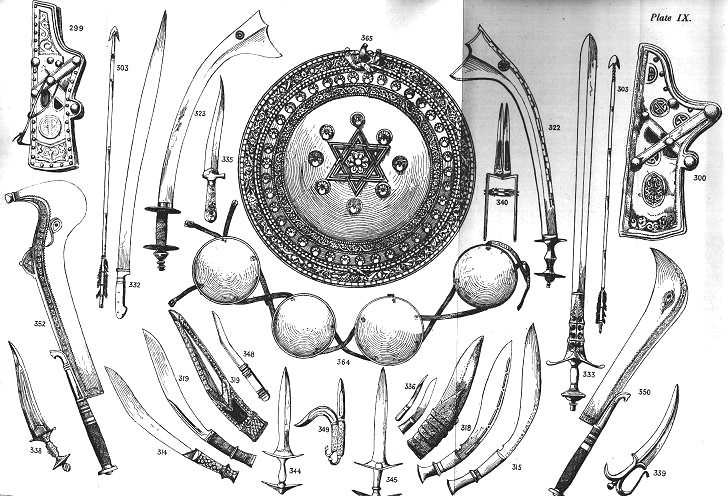
Nepal weapons

Central India weapons
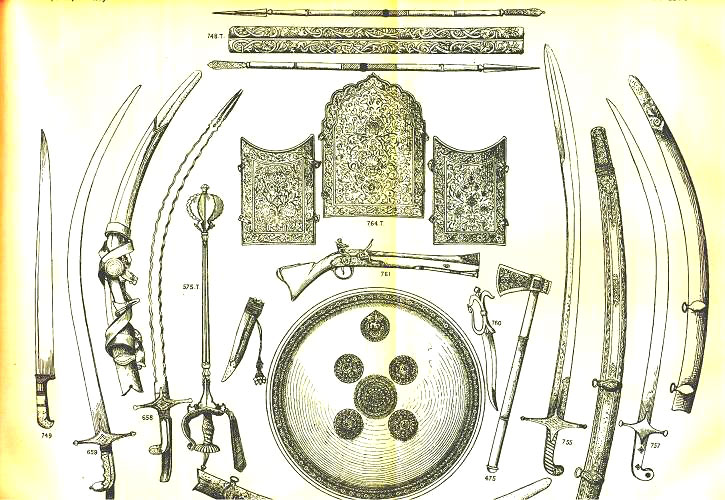
India - Persia weapons
Back to Contents
|

 in the 7th century A.D. the country at large was little injured by
them.
in the 7th century A.D. the country at large was little injured by
them. 






